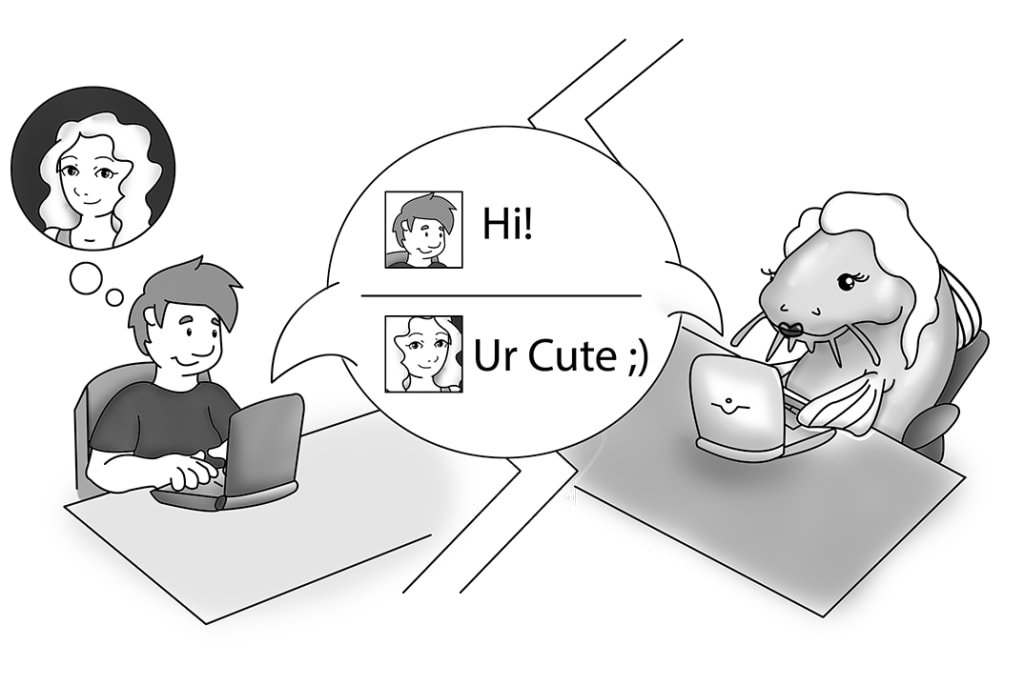What Is a Catfish on the Internet and How to Spot One
How to Spot a Catfish Checklist

A "catfish" is defined as a person creating a false online identity; false pictures, false profile. There is a difference between a fake profile and a catfish though. Many marketers use fake profiles to brandish "likes," "shares," "retweets," etc., and generally, a fake profile won’t reach out to anyone. But a catfish is someone who uses that fake persona to either sell a service (these conversations are usually initiated by "bots," or programs with pre-programmed messages, to a real user) or a real person, essentially present themselves falsely to garner attention, friends or romantic relationships in an internet setting.
The easiest type of catfish to spot is probably the "bot" catfish. These profiles are often generated by computer programs, pictures often uploaded very close together with disregard for the look of authenticity on the profile. Typically on a real profile, you would see pictures spread out over a long time. The person’s look could change from day to day in their pictures—this is because bot programs operate under a user’s programming and are not designed to look real, but just to create a means to an end. These profiles are often shut down very quickly, so they’re generally new and don’t have a lot of friends or interaction on their profile. The easiest way to spot this type is by the messages they will send you—they’re pre-programmed messages that often make little sense to what you’re responding with—very generic replies. Usually they’re porn bots, and they’ll redirect you to some live webcam chat service, or worse yet, they’ll send you to a phishing page to try to steal your password or identity. It goes without saying: always check the URL (hyperlink, web address) carefully before entering your password or personal information. Probably would be wise to not follow links from strangers anyway, with all the phishing that goes on out there.
In this article, we’ll be covering the specific type of catfish that is a human seeking other humans for social interaction. Typically these are lonely people with low self-esteem, but if you’ve ever seen MTV’s hit show Catfish, you may have noticed a lot of these people are just scared to be themselves, but that doesn’t make it any less painful to become intertwined and close with these people because there aren’t a whole lot of things worse than being completely misled in a relationship and being led to believe someone is completely different than who they actually are can be very disappointing! And while short of actually confronting them, there is no real way to be totally sure, here are some ways to spot a human catfish!
1. Always be suspicious if a person refuses to Skype, Video Messenger Chat, Facetime, etc.

Remember, these are people who don’t want you to see their faces. They are hiding behind a persona for a reason. Of course, there are many people who highly regard their privacy, but if you’ve begun to cultivate a relationship with a person and both of you have equally invested some time into it, normally they’ll be willing to video chat. Most laptops and cellphones come equipped with a camera, and although cameras break, there’s a fairly low likelihood of all of someone’s camera not working, or them being busy ALL the time.
2. Checking photos is like checking facts.

I mentioned earlier of the bot catfish how the pictures will oftentimes be uploaded very close together, looks changing dramatically from photo to photo as if they’ve been lifted from another profile or a database of images. For most human catfish this is not generally the case. They will often times take photos from someone’s Instagram and these images will be relatively up to date. It may appear even to be in regular intervals much like a real profile. But are they absolutely just too perfect in these images all the time? Do they not have a lot of interaction on the photos; just a few profiles consistently interacting? Some red flags to watch out for. Google has a reverse image search, and while this won’t always catch a person red-handed stealing pictures because sometimes the profiles or databases they’re stealing images have privacy settings that prevent them from being found in a Google search, it’s a good place to start.
3. Check out their interaction.

I mentioned those perfect pics. If someone has perfect pictures, it’s a pretty solid assumption that their profile was not just recently created. They probably also have a lot of friends, likes, comments, and tags in images, places, statuses. Granted, yes, people can be hacked, but there’s also a high likelihood of this person being able to at least get their real friends from that profile back and begin to rebuild. You would likely see early statuses on a new profile about being hacked, and friends pouring in to show support. These people pouring in would not appear to be strangers. You also would expect to see a high number of comments, likes, and friends on these perfect profiles. If you’re seeing only a few friends and minimal interaction seemingly coming from strangers, now’s a good time to get suspicious. Expect real people to have real friends who comment inside jokes, or reference outings they’ve had. The absence of these can definitely point to a catfish!
4. Don’t be afraid to ask for photos.

Remember! You’re investing time into this. It’s not way out of line to ask for photos. If they’re flat out refusing, or they’re just recycling pics from their profile—that’s another red flag! Don’t be afraid to ask them to make you a sign. Yes, it’s a cheesy reference to the good ol’ days of Myspace, but it can also be a cute way to show off your new relationship as well. If they won’t provide, or become harsh and defensive, red flags EVERYWHERE! A real person who is also invested in the relationship will generally not mind. It’s pretty understandable to question an online relationship at first. We all like to know who we’re talking to.
5. Search their info online.

Phone number, first and last name, even address is all within the public record. It could be that they’re using a fake name, but if they’ve given you a phone number, you could use a reverse phone number search and see if the name is anything close to the one that you’ve been given. As with any new relationship, ASK QUESTIONS. A lot of catfish will jump through hoops to keep their identity secret with lie after lie, so trust your gut. If things aren’t adding up, don’t be afraid to fact check them, and don’t be afraid to probe. Don’t be afraid to confront them and ask for proof—after all, they are the one lying!
***I hope this helps! Good Luck!
TAGs:
Ultimate Catfish Check List
What is a catfish?
How To Spot a Catfish

About the Creator
Aaceeo Picosoneo
World Music Artist, Entertainer, Poet, Self-helper, and blogger... Just your everyday Wordsmith






Comments
There are no comments for this story
Be the first to respond and start the conversation.